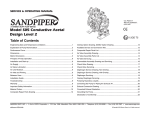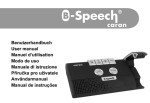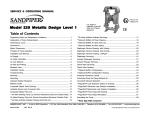Download HL service manual
Transcript
TILLOTSON, Clash Industrial Tralee, Ireland County LTD. Estate Kerry Ref. No. SM/I Printed in U.S.A. INTRODUCTION The gasoline engine industry's universal acceptance of Tillotson's original diaphragm carburetor has resulted in the development, by Tillotson engineers, of the "HL " Series carburetor . Designedwith a minimum of parts, this lightweight, compact carburetor includes an integral fuel pump and filter in one small unit. The all position mounting feature allows a wide range of possible applications. Information contained in the following pages is presented as an aid to understanding construction, operation and servicing of the "HL " series carburetor. HL SCHEMATIC CONSTRUCTION DATA The "HL" series carburetor is a lightweight, aluminum die cast carburetor composedof four basic parts: metering body, main diaphragm cover plate, fuel pump body and strainer cover. The diaphragm carburetor incorporates many of the same type components found in float type carburetors: choke,throttle, idle and main mixture adjustment screws, idle speedscrew and inlet needle and seat. Two styles of main and idle adjustment screwsare available: "0"ringtypeand spring loadedpacking type. Both types are designed to perform the dual purpose of sealing the metering chamber and providing adjustment screw friction. A special insert, housedin a brass cage,forms a seat for the inlet needle.An inlet tension spring exerts a pre-determined force on the inlet control lever which holds the needle on its seat. A metering diaphragm is subjected to engine suction on the metering chamber side and atmospheric pressureon the vented side. Atmospheric pressureon the vented side pushesthe diaphragm toward the inlet control lever, openingthe inlet needle to allow fuel to enter the metering chamber, from which it is then delivered into the mixing passages. The vented side of the metering diaphragm may be vented either directly to the atmosphere,or in the caseof a balanced carburetor, may be balanced (internally vented) to the choke bore. The balanced type can berecognizedby a brasstube in the choke bore which is connectedinternally to the vented side of the diaphragm. The purposeofintemal balanceis to offset the enriching or choking effect of a partially dirty air cleaner. Some carburetor metering systems include a ball check type main nozzle. These can be identified by the brass cage located in the venturi choke band of the body casting. The ball check valve allows fuel to flow into the mixing passage and prevents air from flowing into the metering chamber. The movement of the pump diaphragm draws fuel into the fuel chamber and a reverse movement of the diaphragm forces fuel out of the fuel chamber through the inlet needleand seat into the metering chamber. Movement is causedby pulsation from the engine, acting on the diaphragm. A plastic turret type inlet connection is the cover to the fuel strainer section of the carburetor and can be rotated 360 degreesfor any required fqel connection location. The strainer consists of a fine mesh screento insure clean fuel supply to the metering section of the carburetor . ADJUSTMENT INSTRUCTIONS To properly adjust carburetor for best performance the engine must be thoroughly warm. INITIAL ADJUSTMENTS: To start a cold engine, first carefully close, by turning clockwise, both idle and main adjustment screws. Open main adjustment screw counterclockwise approximately one and one quarter (114)turns. Open idle adjustment screwthree quarters (:1;4) turn. Back idle speedregulating screw off its contact with throttle stop lever, then turn it inward about one (1) full turn so as to slightly open throttle shutter. Open fuel line shut off valve, closechoke shutter, partly openthrottle shutter and pull starting cord. When enginefires, open choke shutter slightly and idle the engine. Do not race engine. Then as engine warms, openchokeshutter. To start a warm engine it should only be necessary to pull starting cord, if the carburetor is properly adjusted. FINAL ADJUSTMENTS: Completely close throttle shutter and readjust idle speedregulating screw so engine idle speedis approximately 1200 RPM for lawn mowers-2000 to 2500 RPM for chain saws-then slowly readjust idle adjustment screw to obtain smooth and even engine performance. Poor acceleration may result from setting the idle mixture too lean. DO NOT FORCE ADJUSTMENTS INTO SEATS! STARTING CHOKE OPERATION Starting an engine with the "HL" Carburetor involves the same methods that are used in a conventional float feed carburetor. However, since a diaphragm carburetor doesnot have the advantage of a great reservoir of fuel upon which to operate, the technique changes somewhat. When starting a cold engine, place the choke shutter in the closed position and throttle shutter in a cracked or open position. Several pulls on the starter may be neededto raise the fuel pressureto the required amount. As the engine is pulled through with the choke in closed position, engine suction will be transmitted to the diaphragm fuel chamber through both primary and secondary idle discharge parts as well as the main fuel discharge part, creating a low pressurearea on the fuel side of the main diaphr~gm. Atmospheric air pressureon the oppositeside will forcethe main diaphragm upward causing the diaphragm button to depressthe inlet control lever, overcoming inlet tension spring pressure,permitting fuel to enter through the inlet seat, by forcing inlet needle off its seat contact, then into the fuel chamber side of main diaphragm, up through the idle and main fuel supply orifices and channels, and out the discharge parts to the engine. In starting an engine that has been idle and not running for more than an hour, it will be necessaryto operateand maneuver the choking mechanism for approximately three (3)to ten (10)secondsdepending on how cold the enginehas become.The length of time spent warming the engine is only necessary to the extent that the engine can be madeto idle, accelerate and run satisfactorily under wide open throttle conditions; IDLING OPERATION When engine is idling, throttle shutter is in a partially cracked position. Engine suction is transmitted through the primary idle fuel discharge port to the fuel chamber side of main diaphragm via the idle fuel supply channel. Again, the main diaphragm is forced upward by atmospheric pressure,depressingthe inlet control lever overcoming inlet tension spring pressureand permitting fuel to enter through inlet seat, by forcing inlet needleoff its seatcontact, and filling the fuel chamber side of main diaphragm. The fuel is then drawn up through idle fuel adjustment orifice and deliveredto the engine through primary idle discharge port. 4 INTERMEDIATE OPERATION Fuel is delivered into and through the carburetor in the same manner as when the engine is idling. However, as the throttle opens and engine speedincreases, more fuel is demanded from the carburetor and supplied to the engine by valving in the secondary idle discharge port located immediately behind the throttle shutter. As the throttle shutter continues to open and engine speedincreases, the velocity of air through the venturi createsa low pressure area at the venturi throat and diminishes the suction on engine side of the throttle shutter. When the pressure at the venturi throat is less than existing within main diaphragm fuel chamber, fuel is drawn up through main fuel adjustment orifice and out main fuel discharge port into air stream entering engine intake. HIGH SPEED OPERATION As the throttle shutter progressively opens from intermediate position to full open position, the air velocity through the venturi increases and fuel is metered up through main fuel adjustment orifice and main fuel discharge port in accordance with the power requirements of the engine. The action of the main diaphragm is the same as previously described with suction required to operate the diaphragm being transmitted through the main fuel discharge port. SUPPLY ATMOSPHERIC PUMP IMPULSE AIR FUEL FUEL UNDER PRESSURE AIR FUEL 5 UNDER VACUUM HOW TO DISASSEMBLE FC ~R The model "HL" carbureior can be cleaned under adverse conditions-workih'g on a clean surlac~with a minimum of tools. Before disassembling carburetor it is IMPERATIVE to flush it clean of sawdust and dirt by pouring gasoline over it and tools. 1. Remove strainer cover retaining screw and plastic cover. 2. Remove strainer cover gasket and strainer screen. 3. Remove screws and fuel pump body. 4. Removefuel pump diaphragm and gasket. 5. Removemain diaphragm cover plate. 6. Removemain diaphragm. 7. Removemain diaphragm gasket. 8. Remove inlet control lever fulcrum pin, lever and tension spring. 9. Removeinlet needle. 10. With a thin wall 5/16" Hex socket carefully remove the inlet seat. Remove inlet seat gasket. When reinstalling seat, tighten only from 25-35 inchpounds or 34 Kg-Cm. SERVICE When reassembling the inlet control lever and spring, care should be taken to seethat the spring rests in the well of the metering body and locates on the dimple of the inlet control lever , (as illustrated below). CAUTION: Do not stretch spring. Inlet control lever is properly set when flush with floor of diaphragm chamber. CLEANING AND REPAIR 11. Remove idle and main adjustment screws. 12. When reinstalling "0" ring type adjustment screws, lubricate with #30 SAE oil to prevent seizing. Packing spring type adjustments do not require lubrication. 13. The ball check type main nozzle can be removed by tapping it out of the body casting into the venturi with a small punch. A replacement ball checknozzle should be pressed into the casting with the cross holes in line with the main adjustment needle.The brass cageshould be pressedflush with the metering chamber casting. Before reassembling the carburetor (in reverse order as outlined above), wash ALL component parts in clean gasoline and blow off with compressedair. The channels in the metering body should be cleaned by blowing through the idle and main adjusting orifices. All fuel passagesin the three castings should be cleaned with compressedair. Do not clean orifices or passages with wires or drills as this might cause damage and incorrect operation of the carburetor. HINTS Be certain main diaphragm, gasket and cover casting are carefully fitted over the three small pins cast in rim at bottom of metering body; also the fuel pump gasket, diaphragm and fuel pump body, over similar pins at bottom rim of main diaphragm cover casting. Evenly tighten fuel pump body retaining screws to insure complete seal of casting separations at both diaphragms. Frequent cleaning or replacemnet of fuel strainer screen will aid satisfactory operation of the carburetor . CAUTION: Under extreme conditions of clogged idle fuel supply channel and discharge ports, it may be necessary to remove the channel welch plug. If so, it must be very carefully done in following manner: 1. Drill a 1111" diameter hole through the :VII" diameter welch plug. This hole should just break through the welch plug. Deeper drilling will seriously damage the body casting and its discharge ports located close behind the welch plug. C)nsomemodels an additional smaller 1;4"diameter channel welch plug is used. It is not necessaryto removethis plug. 2. Carefully pry out welch plug, then clean discharge ports and cross channels. Now install new part 02531 (:VII"diameter, 1132" thick) welch plug by placing it in casting shoulder, convexed side upward; then flatten to a tight fit with a 5116" diameter flat end tool. ~ TROUBLE , Carburetor Floods 1. Dirt or foreign particles needle from seating. preventing 2. Diaphragm lever spring on lever dimple. 3. Diaphragm carburetor. improperly SHOOTING inlet Remove, clean and replace not seated installed Remove lever and reinstall in Replace diaphragm or correct installation Engine will Not Accelerate 1. Idle adjusting 2. Incorrect screw set too lean. setting Enrich idle adjustment lever. Reset 3. Diaphragm cover plate loose. Tighten 4. Diaphragm gasket leaking. Replace Remove diaphragm cover, diaphragm lever and main adjusting screw. Clean out orifice by blowing through main adjustment threaded hole. 5. Main fuel orifice Engine Will Reset to best idle idle adjustment. 2. Idle discharge 3. plugged. Not Idle 1. Incorrect ~ on diaphragm Diaphragm ports lever set or channels Blowout with compressed air, or, if compressed air is not available, clean and flush with gasoline. clogged Reset daiphragm.lever so it is flush with the floor of the diaphragm chamber. Reset incorrectly. 4. Throttle shutter cocked bore causing fast idle. in the throttle 5. Dirty nozzle check valve. Clean or replace 6. Welch plug covering the idle discharge ports does not seal. This causes the engine to idle with idle adjustment shut off. Replace welch plug, following outlined in service hints. Engine Runs Out 1. Tank vent 2. Leak in fuel system fuel 4. Main orifice fuel Carburetor Lean not operating 3. Ruptured Runs pump from Clean, if possible, correctly. tank Tighten to pump. diaphragm. Rich With Main NOTE: IN MAKING Set engine CARBURETOR or replace or replace fittings or line Replace Clean plugged Adjustment Shut 1. The Vs" diameter nozzle channel plug, or nozzle check valve cage, is not sealing. GENTLY-DO instructions ADJUSTMENTS NOT RAM ADJUSTMENTS idling speed in accordance Off Install new plug or new cage TURN ADJUSTMENTS CAREFULL Y AND INTO SEATS. with engine manufacturer's recommendation. TROUBLE SHOOTING lei Inlet Line must be tight COV~R Be sure all SCREW CO ER V Pump Body Screws are tighttoinsure--BODY perfect seal at the parting surfaces. Remove ) GASKET SCREW Cover SCREEN -place bcrew, Thoroughly gasoline -I ~ screen. or by Cover, clean blowing t2asket Screen through and with clean with com- pressed air. Install Screen next to Pump Body casting, then gasket. Hold Cover in and tighten Cover Screw. PUMP BODY Pump Gasket and Pump Diaphragm must locate on cast pins, at underside of DiaCover rim, to insure correct installation and operation. Pump Diaphragm must be clean and free of breaks or punctures. PUMP A TMOSPHERIC VENT--- DIAPHRAGM Diaphragm COVER\ MAIN DIAPHRAGM~ IDLE SPEED REG. SCREW DIAPHRAGM' GASKET -INLET CONTROL SPRING --i NEEDLE. INLET SEAT~ PLUG METERING CHAMBER .--~ i ~~ --INSERTA ( CHOKE SHAFT FRICTION PIN / SPRING ~ Drain Plug Screw must seal tightly. Main Diaphragm and BODY SPRING Press in place flush with -BRASS body casting. Gasket, Diaphragm Cover Casting, must locate on cast pins, at the body rim, to insure cor.rect installation and operation. Main Dia!phragm must be clean and free of breaks or punctures. Its metal disc must not become bent and should always retain tight fit to rubberized body section. ~ ."i; T..~ : GASKET' . WELCH PLUG OISCHARGE PORTS ~- PLUG SCREW. , PACKING. .FULCRUM PIN WASHER- ADJUSTMENT SCREW To inspect an(j clean Inlet Nee(jle ana Seat, first remove Fulcrum Pin an(j Control Lever, then inlet needle, The Inlet Seat can now be carefully removed with a 5/16" hex socket wrench. CAUTION' If Inlet Seat is not handled with ,.care the small Insert may fall out unnoticed. Remove Gasket and replace with new one before reinstalling Inlet Needle and Seat by reversing above procedure. IMPULSE CHANNEL Welch Plug must seal tightly. ldle Discharge Ports must be open.














